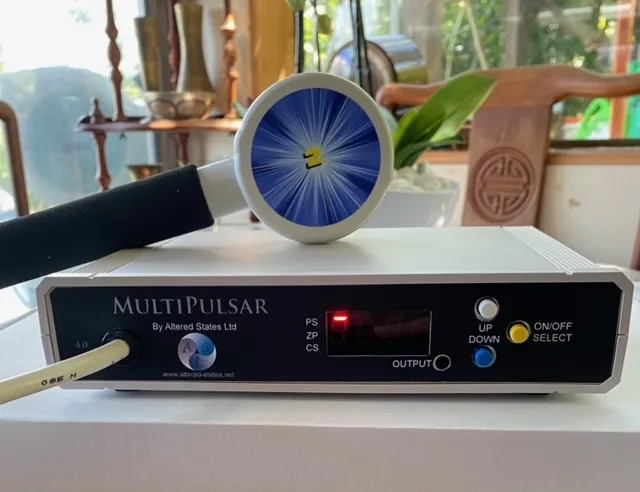Bone density changes in osteoporosis-prone women exposed to pulsed electromagnetic fields (PEMFs).
Tabrah F, Hoffmeier M, Gilbert F Jr, Batkin S, Bassett CA.
University of Hawaii School of Medicine, Straub Clinic and Hospital, Honolulu.
To determine the effect of a 72 Hz pulsating electromagnetic field (PEMF) on bone density of the radii of osteoporosis-prone women, the nondominant forearms of 20 subjects were exposed to PEMF 10 h daily for a period of 12 weeks. Bone density before, during, and after the exposure period was determined by use of a Norland-Cameron bone mineral analyzer. Bone mineral densities of the treated radii measured by single-photon densitometry increased significantly in the immediate area of the field during the exposure period and decreased during the following 36 weeks. A similar but weaker response occurred in the opposite arm, suggesting a "cross-talk" effect on the nontreated radii, from either possible arm proximity during sleep or very weak general field effects. The data suggest that properly applied PEMFs, if scaled for whole-body use, may have clinical application in the prevention and treatment of osteoporosis.
J Bone Miner Res. 1990 May;5(5):437-42.
Prevention of osteoporosis by pulsed electromagnetic fields.
Rubin CT, McLeod KJ, Lanyon LE.
Musculo-Skeletal Research Laboratory, Department of Orthopaedics, State University of New York, Stony Brook 11794.
Using an animal model, we examined the use of pulsed electromagnetic fields, induced at a physiological frequency and intensity, to prevent the osteoporosis that is concomitant with disuse. By protecting the left ulnae of turkeys from functional loading, we noted a loss of bone of 13.0 per cent compared with the intact contralateral control ulnae over an eight-week experimental period. Using a treatment regimen of one hour per day of pulsed electromagnetic fields, we observed an osteogenic dose-response to induced electrical power, with a maximum osteogenic effect between 0.01 and 0.04 tesla per second. Pulse power levels of more or less than these levels were less effective. The maximum osteogenic response was obtained by a decrease in the level of intracortical remodeling, inhibition of endosteal resorption, and stimulation of both periosteal and endosteal new-bone formation. These data suggest that short daily periods of exposure to appropriate electromagnetic fields can beneficially influence the behavior of the cell populations that are responsible for bone-remodeling, and that there is an effective window of induced electrical power in which bone mass can be controlled in the absence of mechanical loading.
J Bone Joint Surg Am. 1989 Mar;71(3):411-7.
Pulsed electromagnetic fields prevent osteoporosis in an ovariectomized female rat model: a prostaglandin E2-associated process.
Chang K, Chang WH.
Department of Biomedical Engineering, Chung-Yuan Christian University, Chung-Li, Taiwan, Republic of China.
With the use of Helmholtz coils and pulsed electromagnetic field (PEMF) stimulators to generate uniform time varying electromagnetic fields, the effects of extremely low frequency electromagnetic fields on osteoporosis and serum prostaglandin E(2) (PGE(2)) concentration were investigated in bilaterally ovariectomized rats. Thirty-five 3 month old female Sprague-Dawley rats were randomly divided into five different groups: intact (INT), ovariectomy (OVX), aspirin treated (ASP), PEMF stimulation (PEMF + OVX), and PEMF stimulation with aspirin (PEMF + ASP) groups. All rats were subjected to bilateral ovariectomy except those in INT group. Histomorphometric analyses showed that PEMF stimulation augmented and restored proximal tibial metaphyseal trabecular bone mass (increased hard tissue percentage, bone volume percentage, and trabecular number) and architecture (increased trabecular perimeter, trabecular thickness, and decreased trabecular separation) in both PEMF + OVX and PEMF + ASP. Trabecular bone mass of PEMF + OVX rats after PEMF stimulation for 30 days was restored to levels of age matched INT rats. PEMF exposure also attenuated the higher serum PGE(2) concentrations of OVX rats and restored it to levels of INT rats. These experiments demonstrated that extremely low intensity, low frequency, single pulse electromagnetic fields significantly suppressed the trabecular bone loss and restored the trabecular bone structure in bilateral ovariectomized rats. We, therefore, conclude that PEMF may be useful in the prevention of osteoporosis resulting from ovariectomy and that PGE(2) might relate to these preventive effects. Copyright 2003 Wiley-Liss, Inc.
Bioelectromagnetics. 2003 Apr;24(3):189-98.
Hip Problems
Electromagnetic fields on loosened hip prostheses. Results showed an increase
of bone density in all patients receiving PEMF treatment compared to only 60
percent of controls. The authors argue such findings suggest PEMF elicits early
bone reconstruction, which enhances early weight bearing.
Pulsed electromagnetic fields (50 Hz, 50 G) in treating aseptic loosening of
total hip prostheses. PEMF therapy consisted of 20 minutes per day for 6 days
per week over a total of 20 such sessions and was begun, on average, a year
and a half following the start of loosening. Results showed PEMF to have some
beneficial effects with respect to loosened hip arthroplasties, although it
was not effective in patients suffering severe pain due to extreme loosening.
G. Gualtieri, et al., "The Effect Pulsed Electromagnetic Field Stimulation
on Patients Treated of Hip Revesions with Trans-Femoral Approach," Second
World Congress for Electricity and Magnetism in Biology and Medicine, 8-13
June 1997, "Therapy with Pulsed Electromagnetic Fields in Aseptic Loosening
of Total Hip Protheses: A Prospective Study,"
Joint Disease
3014 patients found pulsed magnetic field treatment at low frequencies and
intensities to be a highly effective, side-effect-free therapy for joint
disease. E. Riva Sanseverino, et al., "Therapeutic Effects of Pulsed
Magnetic Fields on Joint Diseases," Panminerva Med, 34(4), October-December
1992, p.187-196.

